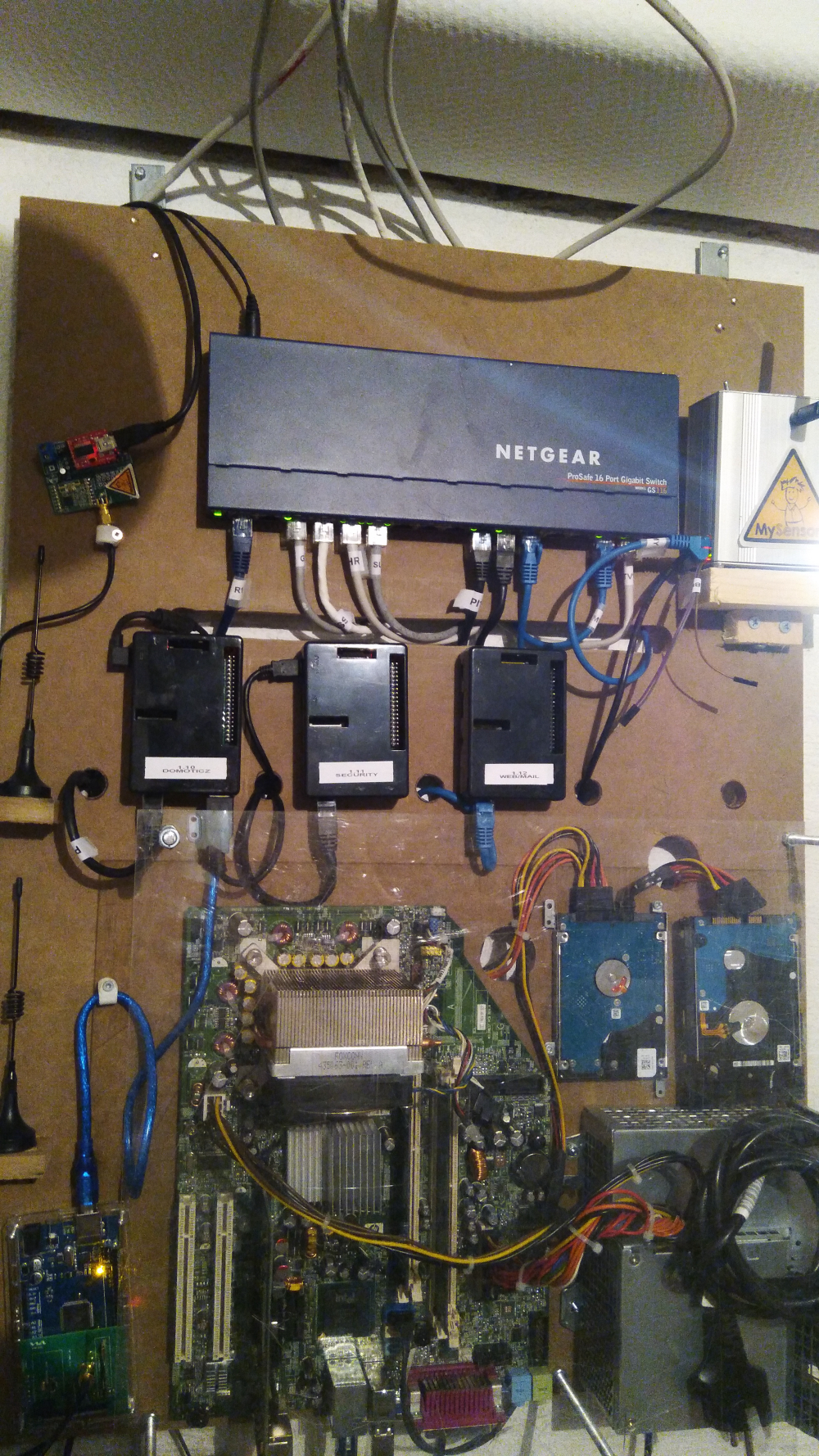What did you build today (Pictures) ?
-
Another hour on my... whatever it is.

Anyone that can recommend a open source router (hardware) or cheap hardware for pfsense which isn't that big and draws that watt amount.
-
@gohan it's a pc with my intention to run pfsense (open source router) but it is old and draws to much power for my taste.
-
How much power does that pc draw?
Mine:
Asrock Q1900B-ITX + pico 12V to atx psu + PCIE Intel Nic 2/4 Gbit ports + SSD can run on 20W or less, but I believe the J1900 Celeron lacks AES for VPN if you care about it.HP DL 380 G7 2xL5640 hex core, 144GB Ram, 4xGbit Nics, SSD, 90W at idle (99.9% of time) and pfsense is only one of the VMs I constantly run, besides OH2, Ubiquity controller, Nextcloud. The ability to snapshot a development VM, or fork (clone) it is a killer feature for me.
Another DL 380 G7 in standby is drawing 15W.
Phu*ck I have some old shitty switches that draw 30-40W, not to mention security cameras, 300-500Wh during the night for all my crazy home automation&security.
-
@gohan it's a pc with my intention to run pfsense (open source router) but it is old and draws to much power for my taste.
@sundberg84 not cheap but 15W (at max load): https://www.aliexpress.com/item/Pfsense-Hardware-Qotom-Barebone-Mini-PC-Nano-itx-Core-i7-4500U-Fanless-Mini-Computer-X86-Router/32799048185.html
Cheaper alternatives:
https://www.aliexpress.com/store/product/2015-new-arrival-direct-selling-bay-trail-J1800-mini-pc-windows-8-1-Qotom-linux-2G/108231_32285025655.html max 10W
https://www.netgate.com/solutions/pfsense/sg-1000.html 2.5W idle -
the little netgate looks cute, but wondering if it would be enough powerful (for streaming etc.)
@sundberg84
when you already have parts laying around, like ram, hdd etc, you could also use intel J3355 or J4205 cpus, maybe better than J1800. J3355 boards are not expensive. Then add a pcie NICs or a simple usb to gigabit..
I would choose micro atx board because often cheaper, same for ram (more compatible ref vs itx boards sometimes are restrictive), and it may be more flexible for pcie slot. That is, if size is not a concern.Or maybe a more powerful cpu, if you plan to factorize lot of things in VMs etc.
In both case it could also allow you to save power by decreasing number of rpis for example. But an interesting math would be pros&cons between features, power consumption saving, cost of a more expensive setup vs years for ROI about power savings (if that is the point)
Maybe we'll see new mini pc router in future with new sbc and mcus..
-
@sundberg84 you could have all the rpi's running on the pc hardware, and save a couple of pennies on the electricity bill..
I exchanged my HA rpi with an atom based machine, as it had 4Gb ram. Now I'm using docker to containerize the different parts of my setup (influxdb, grafana, domoticz, nodered, moquitto, etc.). Ok, it uses a bit more power, but not that much compared to the flexibility that I have now. So now I have a lot of "machines" for handling the different parts.. I can even spin up an experimental domoticz in seconds (I'm playing with mqtt for backbone in my HA setup, instead of mysensors serial protocol, and a lot of http calls to different parts of my system.
-
Some weeks ago I made a video with my children and i had this idea to do something with electronics... so mostly as a testproject I made a introduction video for EasyPCB. I kinda like it... but my English isnt the best in some places.
-
I built a GPIO interface for the Raspberry PI using @GertSanders PCB (link)
I ordered the PCB via OSH Park, successfully soldered 2 and my setup is now much cleaner without these jumper cables.
For the second one, I soldered the NRF directly on the PCB (just because I wanted to gain some height), and everything works flawlessly.Big thank to @GertSanders for his PCB!

My gateway runs mysgw, Mosquitto and Node-Red.
In the back is my Raspberry Dashboard displaying the weather, info from my solar installation and the sensors MQTT messages.
-
I built a GPIO interface for the Raspberry PI using @GertSanders PCB (link)
I ordered the PCB via OSH Park, successfully soldered 2 and my setup is now much cleaner without these jumper cables.
For the second one, I soldered the NRF directly on the PCB (just because I wanted to gain some height), and everything works flawlessly.Big thank to @GertSanders for his PCB!

My gateway runs mysgw, Mosquitto and Node-Red.
In the back is my Raspberry Dashboard displaying the weather, info from my solar installation and the sensors MQTT messages.
-
I made this LoRa shield for an Arduino Pro Mini:

I like it because of the small form factor and because it preserves access to all of the Pro Mini pins. i.e. you can plug it in just like a Pro Mini.
I also gave it 4 header pins for an Si7021 TH sensor, which I haven't yet attached.
-
@sburlot Can't help but see your weather display in the background. What platform is that?
@dbemowsk :-)
It's a Raspberry 3, with a cheap 480x320 screen, and a Python+PyGame script.Start of my script comes from this script
Temp+Humidity comes from mySensors SenseBender Micro via NodeRed/MQTT
Solar power comes from my inverter via a script (also MQTT)
Weather from WeatherUnderground
-
not built today, but someone mentioned fumes extractor, so this is what I built for soldering, light and fume extractor are powered by a small usb rechargeable powerbank. Fan has a active carbon filter behind it and works great for small to medium-ish projects I work on



-
not built today, but someone mentioned fumes extractor, so this is what I built for soldering, light and fume extractor are powered by a small usb rechargeable powerbank. Fan has a active carbon filter behind it and works great for small to medium-ish projects I work on



-
@dakipro Very creative! Thanks for sharing. I've seen those flexible hose things before in other contexts, but I don't know the name. What is the term?
-
-
Thanks. About the cnc pipes, just check if they are US or EU threads, as I was initially planning to fasten them with nuts, but couldn't find any US type in scandinavia. So I had to improvise with A LOT washers and heavy screws as seen in the picture. For the base I used old laptop cooling holder (whatever the name is).
And it works surprisingly well for what I use it, I was expecting it to have a bouncing effect, but it is not that much noticeable.
Way better then that ebay crappy holder with big magnifying mirror that is just so flimsy and annoying.
I was planing to dedicate one hose as a solder feeder, but never bothered with it.Light is a touch-to-adjust type, very very practical , something like this
https://www.ebay.com/itm/5X-6-LED-Night-Light-Soshine-USB-Power-1W-5V-Touch-Dimmer-Warm-White-Light-B2L8/282772437504?epid=721587756&hash=item41d68cfa00:g:gZQAAOSw1cNaMlr5I also have a switch for a fan on the side, and a volt stepup as the fan works on 12V (9 or 10 is my setting).
I have glued the magnets on the right on the last photo, they are then actually on the left of the silicone mat where the "compartments" are

